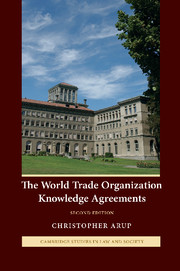Book contents
- Frontmatter
- Contents
- Preface and Acknowledgements
- List of WTO dispute rulings
- List of international instruments
- PART I GLOBALISATION, LAW AND THE WTO
- PART II SERVICES
- PART III INTELLECTUAL PROPERTY
- 6 The Agreement on Trade-Related Intellectual Property Rights
- 7 The case of genetic codes
- PART IV CONVERGENCE
- Index
6 - The Agreement on Trade-Related Intellectual Property Rights
Published online by Cambridge University Press: 23 February 2010
- Frontmatter
- Contents
- Preface and Acknowledgements
- List of WTO dispute rulings
- List of international instruments
- PART I GLOBALISATION, LAW AND THE WTO
- PART II SERVICES
- PART III INTELLECTUAL PROPERTY
- 6 The Agreement on Trade-Related Intellectual Property Rights
- 7 The case of genetic codes
- PART IV CONVERGENCE
- Index
Summary
Like Chapter 4, Chapter 6 has a modest aim of informing the reader. After recounting briefly how the Uruguay Round brought them into existence, it lays out the provisions of the TRIPs agreement for consideration within the context of the book. It notes further the DSB rulings of general import for the agreement, and identifies how the re-regulatory requirements of intellectual property protection have become an essential component of the WTO's interface. Thus, the regulatory reform agenda is not confined to the deregulation of those national legalities which are identified as barriers to liberalisation. It can involve the enactment and enforcement of a set of proactive international standards.
Working though the agreement, the chapter notes how the principles of non-discrimination require that members are to give foreigners no less favourable treatment in their protection of intellectual property. In this respect, the agreement is not much of an advance on existing conventions. In making standards of protection multilateral rather than bilateral obligations, the MFN obligation has the most significance. In the dispute settlement rulings, the standard of national treatment has also received attention. The chapter appreciates that the real potency of TRIPs lies in its requirement that members guarantee high levels of substantive protection to foreigners. Taking each of the agreement's categories of protection in turn, Chapter 6 indicates the nature of the subject matter which they make amenable to protection as intellectual property. It identifies the uses or activities over which the property holder receives control rights.
- Type
- Chapter
- Information
- The World Trade Organization Knowledge Agreements , pp. 285 - 347Publisher: Cambridge University PressPrint publication year: 2008

